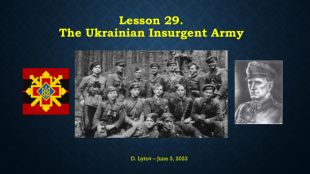The Ukrainian Insurgent Army (Українська Повстанська Армія)
























The Liberation War (1918-1921)2 The Liberation War for the independence of Ukraine under Symon Petliura ended with a bitter defeat. A lot of Ukrainian patriots had to emigrate, and those who stayed were persecuted by the Soviets (Communists) who occupied Ukraine. Smaller parts of Ukraine ended up under control of Poland, Romania, Czechoslovakia, and Hungary.
The Ukrainian Military Organization3 The Sich Riflemen were one of the best military units in that war. Even after the defeat, they remained a strong community with loyalty and discipline. In 1920 Yevhen Konovalets (center), the commander of the Sich Riflemen, created the Ukrainian Military Organization in emigration.
Plast and Prosvita4 The Ukrainian Miiltary Organization cooperated with many other organizations of Ukrainian immigrants. The most important ones, among others, were the Prosvita, which maintained education, and Plast, an organization of boy and girl scouts. Petro Franko, a son of the famous writer, was one of the founders of the Plast.
OUN fights against assimilation5 In the 1930s, the UMO is transformed into the Organization of Ukrainian Nationalists (OUN). The reason: the Polish authorities took a radical approach and implemented the policy of active assimilation of Ukrainians. The OUN responded with terror attacks against the officials. On the right: Mykola Lebed, one of the terrorists, later the leader of the OUN.
The assassination of Yevhen Konovalets6 We should not forget the other important enemy of the OUN, the Soviets from Moscow who controlled the majority of the Ukrainian territory. They were alarmed by the desire of the OUN to restore the Ukrainian state. In 1938 a Soviet agent, Pavel Sudoplatov, met Konovalets (on the photo) and gave him a gift, a box of chocolates, which contained a bomb.
The Carpathian Sich7 In 1938, Nazi Germany occupied Czechoslovakia, but allowed the Slovaks to split away and proclaim their own state. The Ukrainians proclaimed independence of the Carpathian Ukraine, but they were soon attacked by the Hungarians. Those who survived managed to escape and joined the ranks of the OUN.
Taras Bulba-Borovets8 Taras Bulba-Borovets was an influential leader among the Ukrainian emigrants, but he stayed away from Konovalets and the OUN. He managed to infiltrate the territory controlled by the Soviets and created the Forest Sich guerrilla unit, which was later renamed to the Ukrainian Insurgent Army. Alas, Borovets was unable to tackle the problem of low discipline.
A split: the two leaders of the OUN9 In 1941, the OUN split into 2 parts. Some supported Andrii Melnyk (left), who believed that he can rely on the Germans in order to create the Ukrainian state. Others supported Stepan Bandera, who called for military fighting and believed that the cooperation with the Germans will only be short-lived.
Who is the ally?10 Back then, a lot of Ukrainians lived in Canada, the US, and France, but those countries were located too far away from Ukraine, and the independence fighters had little hope for their assistance. On the other hand, the Germans offered cooperation, but their reputation was already tarnished…
The annexation of West Ukraine by the Soviets11 On the other hand, there was an enemy more dangerous than the Germans – the Soviets in Moscow. In 1939 they annexed Western Ukraine and immediately began cruel reprisals and deportations of Ukrainians. With this context, the Germans looked like a better alternative, because they would commit their crimes much later…
Yaroslav Stetsko’s Ukrainian government (1941)12 In 1941, the Germans attacked the Soviets, and the OUN hoped to use this opportunity to take control of Ukraine. However, the very first actions of the Germans showed that they were not much better than the Soviets. The supporters of Bandera proclaimed the independence of Ukraine, and the Germans responded by arresting them.
The Expeditionary Groups of the OUN13 Supporters of both Bandera and Melnyk expected that the Soviets would fall under the German attacks, after which they could eventually gain independence. They sent to Ukraine initiative groups, which began creating local self-government and self-defence.
Reprisals against the patriots15 The Germans were enraged by the activities of the Ukrainian patriots. In December 1941, they began arresting and executing Ukrainian activists, which lasted until the end of the war. Among the victims were famous poets, Olena Teliha (with her husband) and Oleh Olzhych.
The “Double Game”16 In 1942, many people realized that the Germans were as bad as the Soviets. However, the major problem was that the Germans were much stronger and controlled a big territory. The leaders of the OUN ordered their supporters to infiltrate the police and other bodies in order to get as many weapons as possible. Some curious decisions were made: for example, the Agricultural College founded in Lutsk soon became a covert military school for the OUN.
The reunification of the guerilla fighters17 Since April 1942, Dmytro Kliachkivskyi (left) begins reunification of separate guerillas into the united Ukrainian Insurgent Army (the name he borrowed from the earlier units of Bulba-Borovets). Not everybody recognized him as a leader, and he was soon replaced by Roman Shukhevych (right), who completed the unification and began more active resistance to the Germans.
The last years of fighting20 The Soviets eventually suppressed the resistance. In 1950 they killed Roman Shukhevych, and in 1954, they captured Vasyl Kuk, the last leader of the UPA. Their fighting was not in vain. For example, it prevented famine in Western Ukraine, which affected many other territories where the Soviets confiscated food from peasants.


про публікацію авторської розробки
Додати розробку
























